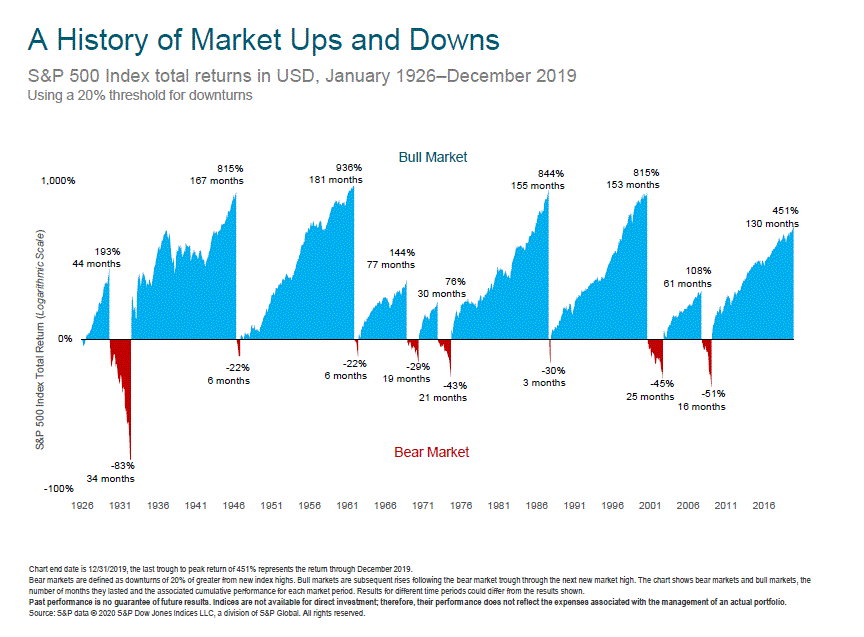How Can “Sequence of Return” Help or Harm You?
Clearly, there is a lot to think about when planning for retirement. While we have a degree of control over many of the choices involved, there’s one big wild card called sequence risk.
Sequence risk is the risk that you’ll encounter negative investment returns in early retirement. This is an important consideration, because the random sequence – or order – in which you earn your returns early in retirement can have a significant impact on your lasting wealth. Simply put, a retirement portfolio that happens to experience positive returns early in retirement has a better chance to outlast an identical portfolio that must endure negative returns early in retirement (if withdrawal amounts are not adjusted) … even if their long-term rates of return end up the same.
Since nobody can predict which return sequence they’ll experience early in their retirement, every family should prepare for a range of possibilities with their retirement planning. > SEE MORE

Posted by:
Waypoint Wealth Management
What Has Historically Followed A Time Like This?
Having patience can be challenging when recent downturns have occurred. But the reality is that some of the biggest innovations (and opportunities) arise out of difficult times. And when it comes to investing, all we have is what those opportunities might bring us in the future. This is why investing can be hard when focusing on short-term movements for your long-term retirement plan.
We can’t go back in time and change the past, but we can return to the evidence, and review what has occurred each time. And while not perfect or any guarantee, we can put the odds in our favor to grow over time.
Our partners at Dimensional put this visual together (below) showing how returns have averaged coming out of downturns of -10%, -20%, and -30%. Please take a look as a reminder of how having a longer-term outlook has helped investors in times like these – to not only stay on course but also to be confident in what can lie ahead. > SEE MORE

Posted by:
Waypoint Wealth Management
A Calm Reflection On The Markets
Many of you may prefer to tune out the financial news, and you may not need much reassurance when we experience bear markets. But the biggest worry that we have is that a client is worried; if that is the case with you please don’t hesitate to call to go over your investment plan.
The most common question we get during times like these is: “your phone must be ringing off the hook.” The truth is, that it is not. That doesn’t mean that we’re less busy in times like these. But we do think the quiet is a testament to not only the planning we’ve done and (hopefully) the perspective we’ve provided you, but also that you’ve placed your trust in us. So thank you for that trust—we don’t take it lightly—and we really mean that we are here for you if you want to call or set up an appointment.
So, another long bull market has come to an end (for now). This happens when a market declines by 20% from its recent high watermark. And, while we tend to focus on the negative aspect (the -20% or more), which we completely understand, we recently came upon the following picture that shows in detail the length and scale of ALL the previous bull markets (and bear markets). What is very evident, is that over time the blue/positive/upturn/bull markets dominate the red/negative/downturn/bear markets.
You can click on the following link to see a larger version of this image: Market Declines and Volatility

This, of course, doesn’t mean that downturns are any less difficult when we’re experiencing them. But sometimes visual evidence can help a long-term investor (like you) remember why we invest in the first place. The positive growth outlasts the negative (every time so far) and the net outcome is expected growth. We don’t know when the next upturn will begin. But staying invested means that we’ll be there when it does.
Past performance is no guarantee of future results. Indices are not available for direct investment; therefore, their performance does not reflect the expenses associated with the management of an actual portfolio.

Posted by:
Waypoint Wealth Management
A Closer Look At Dividends
When generating income for retirement, we take what we call a “total return” approach. Simply put, this is using both the income derived from the investments (from interest and dividends) as well as the investment’s potential gain in price over time. When going about it this way, we can diversify across many investments and we can also put you in the driver’s seat by customizing your income to meet your goals.

One strategy that we hear of often is solely living on an investment’s “dividend”, and attempting to not sell any shares along your retirement journey. However, while dividends can be important, we think they’re just one piece of the overall income puzzle. > SEE MORE

Posted by:
Waypoint Wealth Management
You, Your Retirement, and the SECURE Act
You may have missed the news – buried in a much bigger spending bill and passed in the thick of the holiday season. But after months of nearly bringing it to the finish line, it’s now official: the Setting Every Community Up for Retirement Enhancement (SECURE) Act was signed into law.

The SECURE Act provides a mixed bag of incentives and obligations for retirement savers and service providers alike. Its intent is to make it easier for families to save more for retirement.
That said, “easier” doesn’t necessarily mean less complicated. The following is an overview of the most significant changes that we see for you (our clients), as the SECURE Act starts rolling out in 2020.
Tax-Favorable Retirement Saving
Compared to previous generations, more Americans are living longer, remaining employed into their 70s, and shouldering more of the duty to fund their own retirement. As such, the SECURE Act includes several incentives to start saving sooner and keep saving longer.
- Initial RMD increases to age 72 – Until now, you had to start taking Required Minimum Distribution (RMDs) out of retirement accounts at age 70 ½. RMDs are then taxed at ordinary income rates. Now, you don’t need to begin taking RMDs until age 72. However, if you turned 70 ½ in 2019 or earlier there is no change; the new rules begin for those turning 70 ½ in 2020. Rules for qualified charitable distributions (QCDs) and Roth IRA withdrawals remain unchanged.
- IRA contributions for as long as you’re employed – If you work past age 70 ½, you can now continue to contribute to either a Roth or a traditional IRA. Before, you could only contribute to a Roth IRA after age 70 ½.
- Expanded participation for long-term, part-time employees – Even if you’re a part-time employee, you may now be able to participate in your employer’s 401(k) plan.

Posted by:











